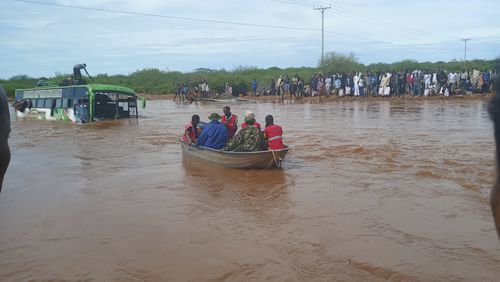People residing around by Lake Victoria should be prepared for potential flooding as the Meteorological Department has predicted increased rainfall in the region throughout this week

The meteorological department stated that areas surrounding Lake Victoria, where some residents have already been displaced, will continue to experience heavy afternoon showers. This region encompasses Siaya, Kisumu, Homa Bay, Migori, Kisii, Nyamira, Trans Nzoia, Baringo, Uasin Gishu, Elgeyo-Marakwet, Nandi, Nakuru, Narok, Kericho, Bomet, Kakamega, Vihiga, Bungoma, Busia, and West Pokot counties.
Although the morning rainfall has largely ceased, it is expected to resume in certain areas on Saturday.
Dr. David Gikungu, the head of the meteorological department, has mentioned that the rainfall will persist throughout the week but is anticipated to decrease on Sunday.
Gikungu stated, “Rainfall is expected to persist over most parts of the country. Heavy rainfall events are likely to occur in some parts of the highlands east and west of the Rift Valley, the Lake Victoria Basin, the Rift Valley, the South-eastern lowlands, the Coast, north-western and north-eastern Kenya.”
The forecast also indicates no relief for Northeastern counties such as Marsabit, Mandera, Wajir, Garissa, and Isiolo, where numerous areas are also experiencing flooding.

Residents expressed concerns regarding the risk of contracting waterborne diseases, as some of their belongings were destroyed by the floodwaters.
Area MCA Billy Odhiambo expressed dissatisfaction with the county disaster management team’s handling of the situation.
Odhiambo claimed that they had previously raised the issue of the Kobura residents’ plight on multiple occasions and were promised swift action.
The MCA expressed his disappointment that the affected people continue to suffer despite the existence of allocated funds for responding to disasters and emergencies.
“A supplementary budget was passed with Sh30 million going towards disaster management and Sh50 million for emergencies. Why are the funds not being released to assist in this situation?” he questioned.
Odhiambo emphasized the urgent need for intervention to aid the 300 affected individuals within his ward.
“The roads are impassable, but we have been informed that a tractor will arrive tomorrow. Let us wait and see,” he remarked.
Central Kenya and Mt. Kenya are other regions highlighted in the forecast, indicating that they will experience cloudy mornings and evening showers on Thursday and Friday, with morning rainfall resuming on Saturday.
On Tuesday, 51 passengers were rescued after their bus was submerged in floodwaters in Tana River.

The passengers were traveling from Garissa to Nairobi when their vehicle became stranded in Arer, Tana River, due to rising waters.
The Kenya Red Cross (KRC) dispatched two boats to rescue the passengers, with priority given to vulnerable groups such as children.
KRC stated on Tuesday, “All passengers aboard the bus have now been rescued, with priority initially given to women, children, and those who were sick.”
Tana River County Police Commander Ali Ndiema reported that the bus was en route from Garissa to Nairobi and encountered the flooded section around 11:30 p.m. on Monday.
Ndiema mentioned that the bus driver, against the advice of other drivers and passengers, decided to cross the flooded area, resulting in the vehicle being submerged in the heavy waters approximately 50 meters off the road.
The Kenya National Highways Authority (KeNHA) issued a warning to commuters traveling along the Garissa-Nairobi highway (A3) due to flooding in the Mororo area between Madogo and the Tana River Bridge.
According to KeNHA, one lane of the road has been affected by the flooding, posing a significant safety risk to motorists.
KeNHA stated, “This poses a high safety risk to the road users. This road, therefore, shall remain closed until the floodwaters subside and the damaged section is reinstated.”
KeNHA is also monitoring other roads, including the Garissa-Mombasa highway at Bilbil and Charidende in Tana River County, which were washed away by the El Niño floods.




